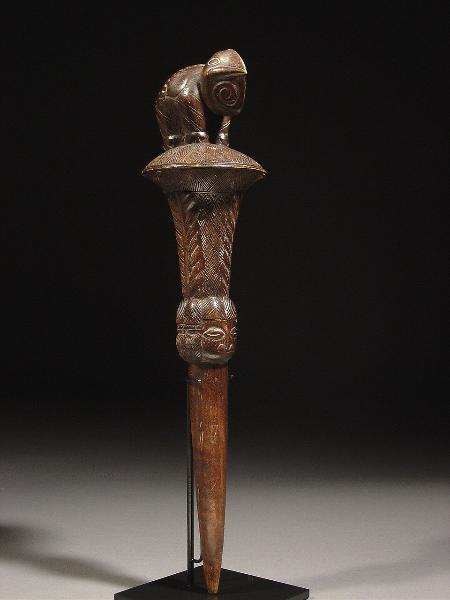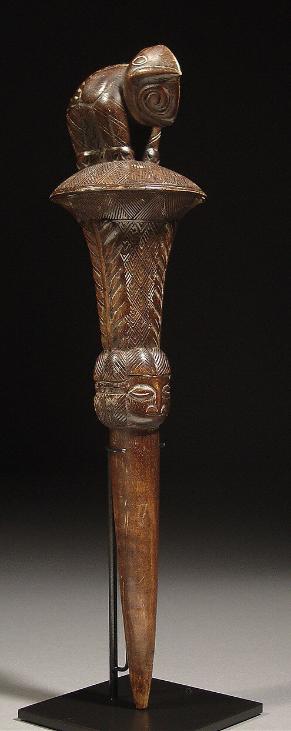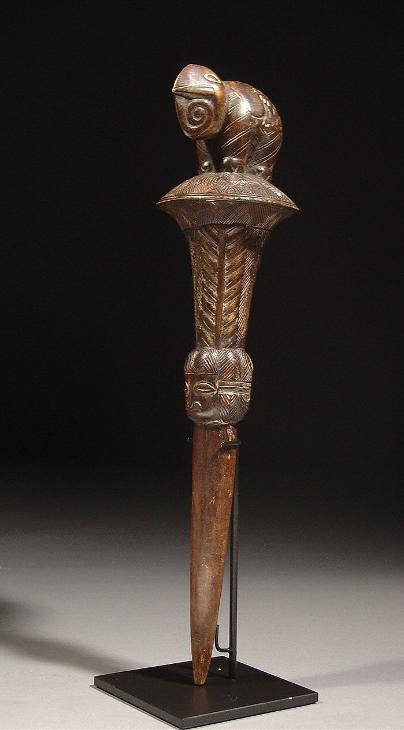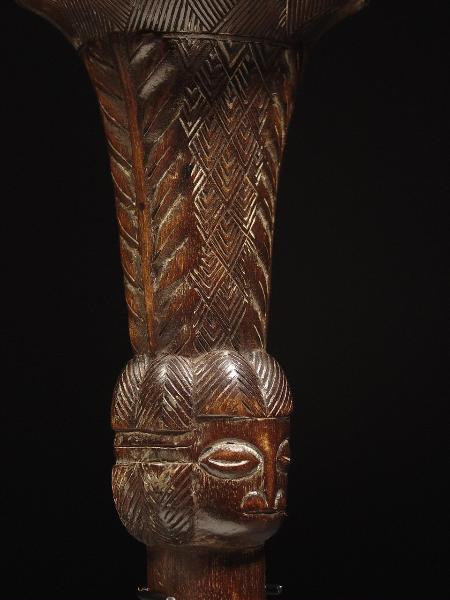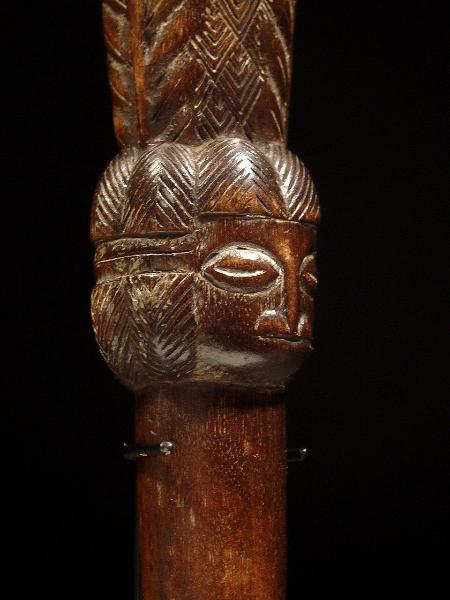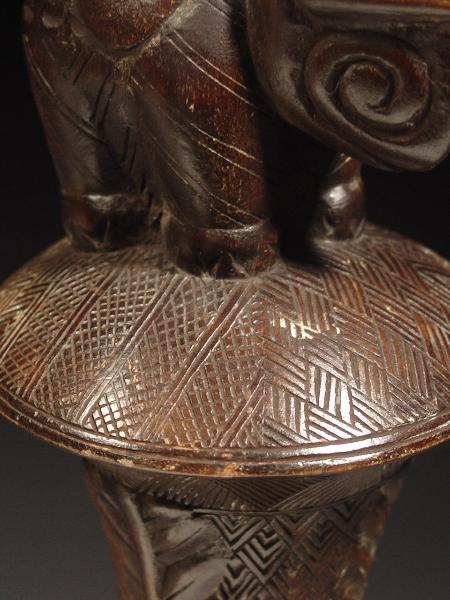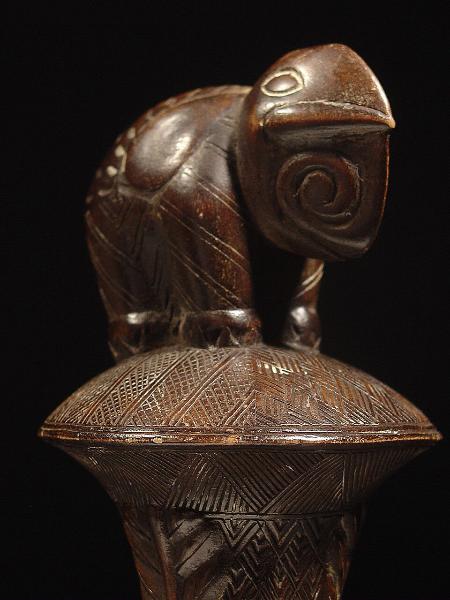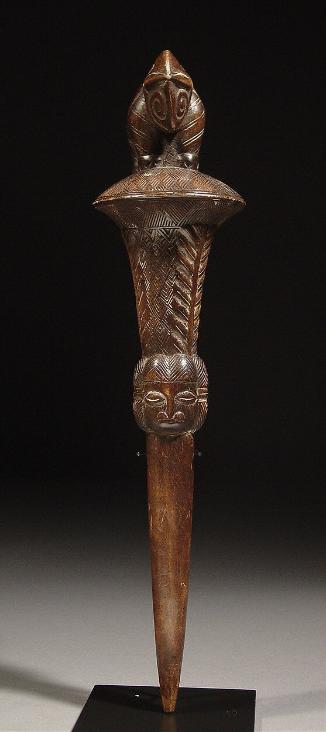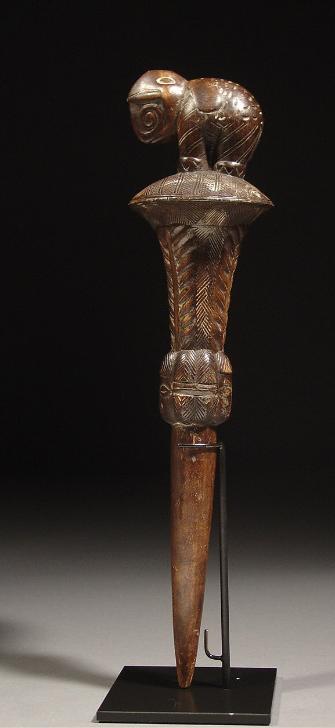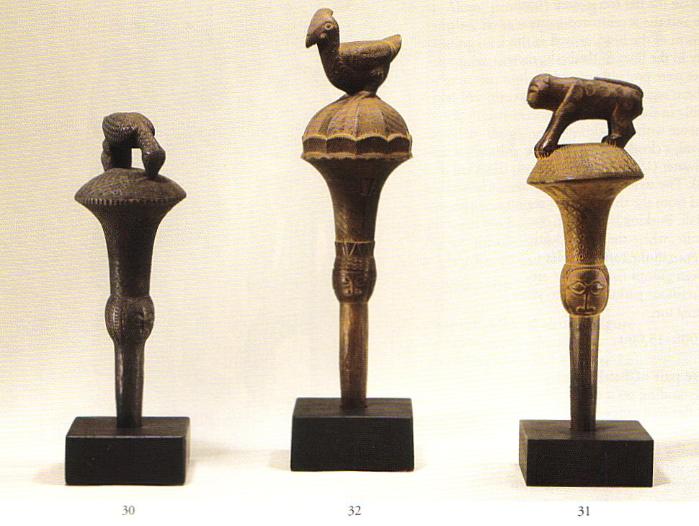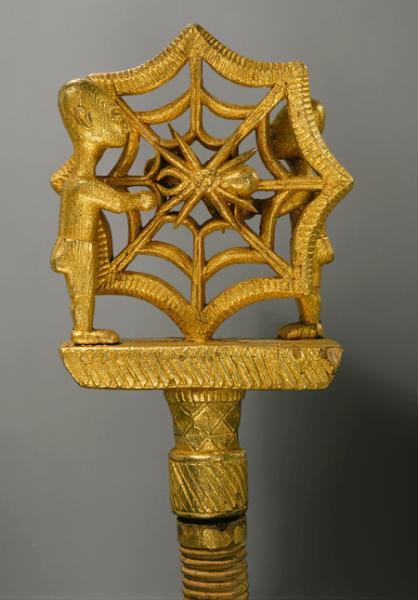
| Baule prestige staff (information on Asante Linguist and Family staffs further down on the page) |
| Baule linguists staff (?) / fly-whisk (?) Provenance: Walking Man Gallery Ex Kaba Collection Measurements: 15" tall (photos by Brian at Walking Man Gallery) THIS OBJECT IS NO LONGER IN MY COLLECTION Information: Fly-whisks and staffs such as this were prestige objects owned by a Baule village chief and notable. During public ceremonies whisks and staffs are brought out for display, a symbol of prestige. The figure on top of this staff most likely represents an elephant. The staff is usually carved from wood and may be coated with gold leaf. Usually the top part of the staff is a symbol designed to communicate specific messages either about the status and authority of the owner or the message he, as a diplomat, is authorized to convey. |
| Click on any photo on the page to see larger version |
| Examples below for reference purposes |
|
| From the book: African Art in Motion Linguist staff Attributed to the BAULE 13.5 inches |
| The examples above are from the Sotheby's auction catalog: African Art from the Egon Gunther Collection New York - November 18, 2000 30 A Baule dignitary's flywhisk the faceted cylindrical shaft with opposed faces beneath a flaring final widi domed top, and surmounted by a bird bent over with head touching the ground, incised with exceptionally fine panels of geometric motif; encrusted dark brown patina, 'HH' and 'EG' in pigment on the shaft. height IPAin. (29.9cm.) Provenance: Collected by Hans Himmelheber in the Ivory Coast Acquired from Hans Himmelheber Cf. Himmelheber, 'Baule Gold-Plated Objects' in African Art and Leadership (1972:187-188, figures 11.1 and 11.2;201-203, figures 11.34, 11.35 and 11.36) for related examples and comparison. This fly-whisk was a prestige object owned by a Baule village chief and notable. During public ceremonies whisks are brought out for display, a symbol of prestige. The bird on the top typically represents a parrot (Garrard 1994:156). estimate $3,000-5,000 31 A Baule dignitary's flywhisk the faceted tapering shaft supporting a finial with janiform faces beneath a flaring element supporting a standing stylized leopard, highly decorated with varied incised geometric motif; medium brown patina, 'HH60' and 'EG' in white pigment on the shaft. ht 13in. (33cm.) Provenance: Collected by Hans Himmelheber in the Ivory Coast Acquired from Hans Himmelheber estimate $1,500-2,500 32 A Baule dignitary's flywhisk the faceted tapering shaft supporting janiform faces beneath a flaring finial in the form of a large umbrella, and supporting a chicken at the crown, highly decorated with varied, incised geometric motif overall; medium brown patina 'HH' and 'EG' in white pigment on the shaft. height 15in. (38.1cm.) Provenance: Collected by Hans Himmelheber in the Ivory Coast Acquired from Hans Himmelheber estimate $2,000-3,000 |
| Examples and information below on Asante Linguists staffs |
|
| Linguist Staff (Oykeame), 19th–20th century Ghana; Akan, Asante Gold foil, wood, nails; H. 61 5/8 in. (156.53 cm) Bryce Holcombe Collection of African Decorative Art, Bequest of Bryce Holcombe, 1984 (1986.475a-c) This object is in the collection of the Metropolitan Museum of Art in New York Magnificent gold-covered staffs like this one are carried by high-ranking officials within the courts of Akan chiefs in an area of West Africa once known as the Gold Coast. Because they are a society that originally had no written tradition, the Akan peoples place an enormous emphasis on speech. The spoken word, in the form of axioms and stories, is the repository of Akan custom and values, and a complete mastery of proverbial lore, combined with an eloquent and insightful way of conveying it, is considered the mark of intellect of highly esteemed individuals. Those who possess this knowledge and an articulate command of language may be appointed as court linguists, the most important nonroyal court officials. Court linguists play an invaluable role in Akan circles of leadership. Their vast knowledge and superior diplomacy make them essential as counselors, ambassadors, legal experts, and historians, and most Akan rulers keep several in their employ. The linguists' staffs of office, carved of wood and covered in gold foil, are said to be modeled after the cane used by the first court linguist, a woman who carried a cane because of her great age. The finials of these staffs commonly illustrate proverbs that assert the ruler's legitimacy and capabilities or praise the linguist's experience and sagacity. This staff is surmounted by two human figures flanking a large web, with a spider positioned at its center. The finial refers to the saying, "No one goes to the house of the spider Ananse to teach him wisdom." Ananse the spider, who brought wisdom and taught weaving to the Akan, is the originator of folk tales and proverbs and is thus linked to linguists. Here, Ananse is the ultimate repository of erudition, as is the linguist at an Akan court, neither of whom should be challenged in that domain. Metropolitan Museum of Art |
|
| Linguist Staff with Rooster and Hen (Okyeame Poma), early/mid-20th century Ghana. Wood and gold leaf H: 170.2 cm x W: 15.2 cm x D: 20.3 cm This object is in the collection of the Art Institute of Chicago Gift of the Richard J. and Barbara S. Faletti Family Collection, 1999.376.1-3 The Asante kingdom was the most powerful of numerous states that emerged at the beginning of the 15th century within the present-day country of Ghana. The kingdom's position between the rich gold fields of the north and the coast, where European ships vied for trade, assured its wealth and maintained its focus on gold as a symbol of affluence and power. Asante art is often related to oral traditions, including messages expressed through proverbs, sayings, or accounts of history. Staffs with decorative finials like this one bearing the figures of a rooster and hen are owned by the official spokesman, or linguist, of an Asante chief as symbols of his office. This finial refers to the proverb, "The hen knows well when it is dawn, but leaves it to the cock to announce.” This proverb may reference the decision-making power of the chief, represented by the rooster, as opposed to the wisdom of the elders, represented by the hen, and the role the linguist plays in mediating between the two. This staff, thus, is not only a royal insignia, but also a symbol of the shrewd and eloquent diplomat that the okyeame, or linguist, must be. |
| The okyeame and abusua poma (linguist's and family staffs) are used for political and judicial purposes. In the king's court, for example, the linguist will carry the poma to express profound messages relating to justice, peace, conflict resolution, and arbitration. The linguist will also carry a staff on diplomatic missions for the chief. In such instance the symbol on the staff will encode the message being carried by the emissary. OKYEAME POMA (LINGUIST'S STAFF) The okyeame is the king's counselor, confidant, orator and diplomat. The term linguist does not fully capture the role and functions of the okyeame in the rich cultural heritage of the Akan. At public functions, the okyeame carries a staff (or mace) of authority. The staff is usually carved from wood and may be coated with gold leaf. Usually the top part of the staff is a symbol designed to communicate specific messages either about the status and authority of the okyeame or the message he, as a diplomat, is authorized to convey on behalf of the king at specific public functions. ABUSUA POMA (FAMILY STAFF) The Akan lineage organization comprises matrilineal clans (mmusua, pl.; abusua, sing.) that have major and minor segments. The clans (mmusua) number seven in total. In various places different names may be used for one and the same abusua. Sometimes, even in the same place, more than one name may be used to refer to same abusua or its minor segment. This leads to some writers to give the erroneous interpretations that Akan mmusua number more than seven. Each abusua is identified both by its proper name and its common emblem, totem or symbol. The beretuo (twidan) abusua's totem is the leopard (etwie or osebo). The aduana (atwea, ntwea, aowin, aborade, or adwinade) is represented by the dog (kraman, bodom) or frog (atwere or aponkyerene). The kona (asokore, ekoona or adonten) abusua is represented by the water buffalo (ekoo). The oyoko (daku, yogo, yoko, oweko, or anona) abusua is represented by the hawk (akroma or asansaa). The parrot (akoo) represents the agona abusua, while the whale (bonsu) or the bat (apane) represents the asinie abusua. Asona (odum, odum-na, dwum or dwumina) abusua is represented by the crow, white crested raven (adene or akonkron). Source: http://www.marshall.edu/akanart//poma.html |
| Additional information on the Asante/Akan Linguist staffs "Linguist Staffs" 'We speak to a wise man in proverbs, not in plain speech,' goes an Akan expression. Nowhere is refined speaking, embellished with proverbial wisdom, more apparent than in the institution of the linguist, a principal counselor and spokesman for a chief. More than a translator, he is also an advisor, judicial advocate, priime minister, political trouble shooter, and historian of state law, lore, and custom--of course chosen for his sagacity, wit, and oratorical skill. Many kings have several linguists, in which case one will be designated chief among them. In the 1970s the asantehene had thirteen linguists, and he may well have more today. Since around 1900 linguists have carried carved, gold leafed wooden staffs of office. Each staff is topped by a figural sculpture that elicits one, and more often several proverbs. These multiple, overlapping meanings are available for use by the quick and witty linguist,who may have several staffs to choose among, enabling him to use the one whose imagery seems the most appropriate for the situation at hand. Akan linguist staffs may have been stimulated by figural staffs from the Lagoons area, where as early as the seventeenth century metal-topped staffs or canes were carried by messengers. But their immediate prototype would appear to be British government staffs given during the late nineteenth century to chiefs, who used them to designate authorized representatives in dealings with the colonial government." Excerpts from A History of Art in Africa, by Monica Blackmun Visonà, Robin Poynor, Herbert M. Cole, and Michael D. Harris |
| Rand African Art home page Asante main page |
